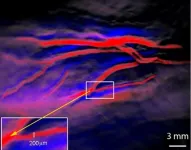(Press-News.org) Scientists have found that the spatial arrangement of plants in drylands can be a sign of the environment degrading, according to a new study.
One of the iconic features of drylands is the striking appearance of islands of plants surrounded by bare soil. This spatial structure of arid vegetation has long fascinated scientists, but now a new study published in Proceedings of the National Academy of Sciences, has shed new light on why these plants group in this way.
An international team of scientists, including from the University of Birmingham, combined field data from 115 sites around the world, and used mathematical models and remote sensing to build a picture of how the environment impacts the special structure of the plant life.
Dr Juliano Sarmento Cabral, Associate Professor for Biodiversity Modelling and Environmental Change at the University of Birmingham who worked on the study, said: “There are two drivers of the biodiversity crisis that are expected to have catastrophic synergies: land use and climate change. We urgently need to understand how ecosystems respond to a lower humidity and less available water, given the increase of extreme drought events expected under the impending climate crisis, something that the UK has already experienced in 2022 first hand. However, the ability of ecosystems to adequately respond to climate change could be jeopardised if they already suffer from human-caused degradation such as overgrazing, depauperate biodiversity and resource exploitation. We are now able to identify tell-tale signs of both the degradation and the ability to cope with a drying environment.”
Dr Sarmento Cabral continued: “Self-organised spatial patterns are a common feature of complex systems, such as microbial communities and mussel beds, and of course dryland vegetation. Researchers have extensively studied implications for this phenomenon, such as functioning and resilience, but until now there was little to no empirical evidence to support this reasoning. To address this gap, we analysed global drylands along an aridity gradient to see if we could find a connection between the aridity levels and the spacing of the plants.”
The scientists found that the spatial structure of vegetation increases with aridity, meaning that the dryer the environment, the more spaced out the plant life will be.
Healthy dryland ecosystems adjust their spatial structure to better cope with stressful environmental conditions, such as drought or high temperatures. As a result, these self-organised vegetation patterns provide drylands with the ability to adapt to these changing conditions while maintaining their functioning, making them more resilient.
However, the researchers also found that this adaptive capacity is lost when ecosystems are already degraded.
Dr Sarmento Cabral continued: “Our study showed that the spatial structure of vegetation plays an essential role in the resilience of arid ecosystems. We also found that degraded ecosystems cannot adapt their spatial structure, and as a result, they become further prone to further degradation as aridity and water shortages increase.”
The scientists suggest that monitoring the changes, or lack of changes, in the spatial plant patterns could be used as an early indicator of ecosystem degradation. This could be a crucial step forward for the development of tools to help manage and preserve dryland ecosystems in a hotter and drier world.
As well as this, because vegetation patterning is also key in other natural systems, such as microbial communities or coastal wetlands, the results of the study could also have implications for systems other than arid zones.
Dr Sarmento Cabral concluded: “As the climate crisis continues and the results are more keenly felt, it is vital that we find ways to closely monitor at-risk ecosystems. Drylands are home to some of our endangered wildlife and rare plant life, so we need to be able to spot early signs of dryland which is suffering so that we can take action to correct and protect what we have left.”
ENDS
END
Spacing characteristics between vegetation could be a warning sign of degrading dryland ecosystems - study
2024-01-29
ELSE PRESS RELEASES FROM THIS DATE:
Researchers spying for signs of life among exoplanet atmospheres
2024-01-29
COLUMBUS, Ohio – The next generation of advanced telescopes could sharpen the hunt for potential extraterrestrial life by closely scrutinizing the atmospheres of nearby exoplanets, new research suggests.
The next generation of advanced telescopes could sharpen the hunt for potential extraterrestrial life by closely scrutinizing the atmospheres of nearby exoplanets, new research suggests.
Published recently in The Astronomical Journal, a new paper details how a team of astronomers from The Ohio State University examined upcoming telescopes’ ability to detect chemical ...
People are inclined to hide a contagious illness while around others, research shows
2024-01-29
A startling number of people conceal an infectious illness to avoid missing work, travel, or social events, new research at the University of Michigan suggests.
The findings are reported in Psychological Science, a journal of the Association for Psychological Science. Across a series of studies involving healthy and sick adults, 75% of the 4,110 participants said they had either hidden an infectious illness from others at least once or might do so in the future. Many participants reported boarding planes, going on dates, and engaging in other social interactions while secretly sick. More than 61% of healthcare workers participating in the study also ...
Racial and ethnic differences in hypertension-related telehealth
2024-01-29
A new study in the peer-reviewed journal Telemedicine and e-Health found that hypertension management via telehealth increased among Medicaid recipients regardless of race and ethnicity during the COVID-19 pandemic. Click here to read the article now.
Jun Soo Lee, PhD, from the Centers for Disease Control and Prevention (CDC), and coauthors, reported that from February-April 2023, the number of hypertension-related telehealth outpatient visits per 100 persons increased from 0.01 to 6.13, and the number of hypertension-related in-person visits decreased from 61.88 to 52.63.
The investigators ...
Henry Ford Health helps advance precision medicine research in Michigan
2024-01-29
Michiganders will continue to have the opportunity to advance medical research aimed at advancing individualized health care through a renewed award to Henry Ford Health + Michigan State University Health Sciences from the National Institutes of Health’s (NIH) All of Us Research Program. The award includes $18.3 million in initial funding to support a consortium of 8 health care provider organizations with a presence in 16 states.
Henry Ford has led the consortium since 2017. The renewed award allows participation to continue until at least 2028. The multimillion-dollar multi-year award represents the largest NIH research grant in Henry Ford’s 108-year history.
All ...
Jobs and geography may affect hearing: New study maps hearing loss by state and county across the US
2024-01-29
Chicago, IL – January 24, 2024 – The first study to map the prevalence of bilateral hearing loss in the United States by state and county finds that rates of hearing loss are higher among men, non-Hispanic Whites, and residents of rural areas. Bilateral hearing loss is hearing loss in both ears.
West Virginia, Alaska, Wyoming, Oklahoma, and Arizona had the highest rates of hearing loss, while the District of Columbia, New Jersey, New York, Maryland, and Connecticut had the lowest (see top ten highest and ...
UChicago engineer driving key role in Great Lakes water transformation
2024-01-29
The Chicago-based Great Lakes ReNEW coalition has been awarded one of the largest, if not the largest, climate awards in the city’s history – up to $160 million over 10 years as one of the inaugural U.S. National Science Foundation’s Regional Innovation Engines.
Authorized in the “CHIPS and Science Act of 2022,” the NSF Engines program is designed to support the development of diverse regional coalitions of universities, local governments, the private sector and nonprofits to create solutions to today’s pressing issues.
Selected from an initial pool of more ...
Hydroxyurea significantly reduces infections in children with sickle cell anemia
2024-01-29
INDIANAPOLIS -- Clinical research led by Indiana University School of Medicine investigators and their collaborators in Uganda has revealed that hydroxyurea significantly reduces infections in children with sickle cell anemia. Their latest findings enhance strong evidence of hydroxyurea’s effectiveness and could ultimately reduce death in children in Africa, the continent most burdened by the disease.
The group’s research, recently published in the journal Blood, revealed that hydroxyurea treatment resulted in a remarkable ...
University of Manchester and SPIE announce $1 million endowment for postgraduate scholarships
2024-01-29
The University of Manchester and SPIE, the international society for optics and photonics have announced the establishment of the SPIE-Manchester Postgraduate Scholarship in Photonics.
The $500k gift from the SPIE Endowment Matching Program will be matched 100% by the University and will be used to support both early-career and returning researchers from the University’s Photon Science Institute in partnership with the Royce Institute, the UK’s national institute for advanced materials research and innovation.
The partnership was announced today (29 January) during the SPIE Photonics West conference in San Francisco.
Photonics is the study of light and its interactions ...
Argonne scientists help scale up nanomaterials for sustainable manufacturing
2024-01-29
New material is self-assembling, long-lasting and recyclable.
As electronic devices get smaller, the materials needed to create them get smaller as well. Nanoscience is the study of extremely small materials that find uses in energy storage, electronics, health and safety applications and more.
Now a team led by the U.S. Department of Energy’s (DOE) Lawrence Berkeley National Laboratory has developed a new self-assembly method to fabricate multilayered 2D nanosheets. A nanosheet is an extremely small, lasagna-like material made of ultrathin layers of polymers and nanoparticles.
These nanosheets have significantly ...
OU scientists tests revolutionary imaging technique for pancreatic cancer
2024-01-29
Researchers at OU Health Stephenson Cancer Center at the University of Oklahoma Health Sciences have embarked on a revolutionary new research study that could improve the detection of a deadly disease — pancreatic cancer — and give patients a chance to live longer, healthier lives.
The research focuses on an innovative combination of imaging techniques: a newly created contrast agent that recognizes pancreatic cancer cells, paired with Multispectral Optoacoustic Tomography, or MSOT. Together, the approach can detect pancreatic cancer cells the width of an eyelash ...






